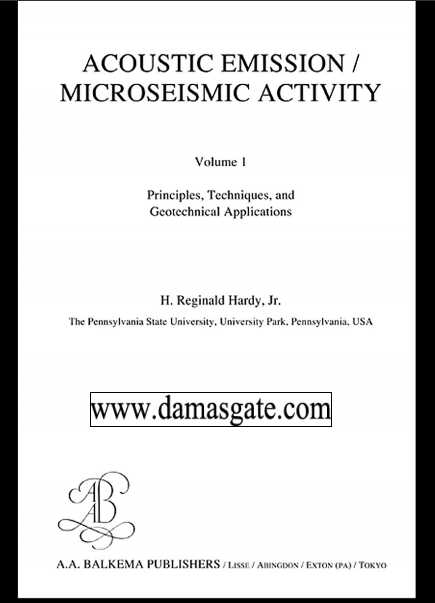Acoustic Emission - Microseismic Activity Principles, Techniques and Geotechnical Applications

ACOUSTIC EMISSION/MICROSEISMIC
ACTIVITY
Preface
In the late 1930s two researchers, L.Obert and W.I.Duvall, from the U.S. Bureau of Mines (USBM), carrying out sonic studies in a deep hard rock mine, discovered to their surprise that a stressed rock pillar appeared to emit microlevel sounds (Obert, 1977). Later, laboratory and field studies by these workers verified that this phenomenon, which is often referred to in nontechnical terms as “rock talk”, is a measure of the mechanical stability of rock material and/ or the associated rock structure. In subsequent years, the early pioneer work of Obert and Duvall has led to the development of one of the truly unique techniques available in the geotechnical field. The understanding of “rock talk”, or acoustic emission/microseismic (AE/MS) activity, as it will be referred to in this text, has developed considerably over the last 60 years. Today it is utilized as a routine tool in a number of geotechnical applications and new ones are rapidly becoming apparent. Through the efforts of an increasing number of researchers and practitioners in this field, improvement in the associated monitoring and analysis techniques, and the development of an improved appreciation of the basic processes involved, scientists and engineers are now better able to understand what stressed rock is “saying”.
Download
*

ACOUSTIC EMISSION/MICROSEISMIC
ACTIVITY
Preface
In the late 1930s two researchers, L.Obert and W.I.Duvall, from the U.S. Bureau of Mines (USBM), carrying out sonic studies in a deep hard rock mine, discovered to their surprise that a stressed rock pillar appeared to emit microlevel sounds (Obert, 1977). Later, laboratory and field studies by these workers verified that this phenomenon, which is often referred to in nontechnical terms as “rock talk”, is a measure of the mechanical stability of rock material and/ or the associated rock structure. In subsequent years, the early pioneer work of Obert and Duvall has led to the development of one of the truly unique techniques available in the geotechnical field. The understanding of “rock talk”, or acoustic emission/microseismic (AE/MS) activity, as it will be referred to in this text, has developed considerably over the last 60 years. Today it is utilized as a routine tool in a number of geotechnical applications and new ones are rapidly becoming apparent. Through the efforts of an increasing number of researchers and practitioners in this field, improvement in the associated monitoring and analysis techniques, and the development of an improved appreciation of the basic processes involved, scientists and engineers are now better able to understand what stressed rock is “saying”.
Download
*